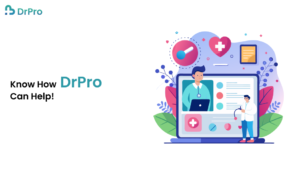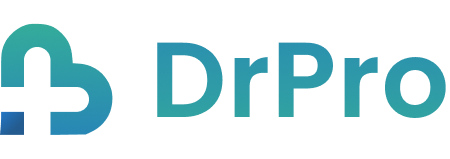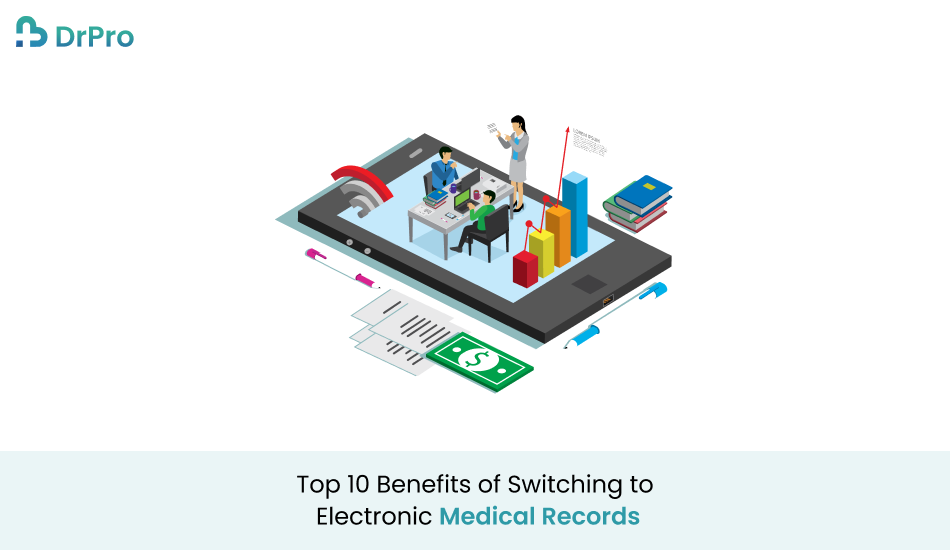Quick Summary
Converting a paper-based health records system into an EMR Benefits can change the face of healthcare practices. In this article, I address the ten key advantages of EMR and have included actual figures to show how EMRs affect effectiveness, patient treatment, and healthcare organization. We also present DrPro, an application aimed at ensuring that healthcare providers well manage the shift in leadership transitions.
Introduction
Today, healthcare has been changing for several years, much of which has been attributed to technological change. Certainly, the use of Electronic Medical Records (EMRs) is one of the most dramatic transformations based on information technology. EMRs are beneficial in so many ways, for the healthcare providers, the patient, and even the staff working at the administrative end. In this article, a checklist of the ten benefits of EMR Benefits will be given to show how EMR Benefits can improve the quality of healthcare services and facility operations.
What is Electronic Medical Records?
Electronic medical records (EMRs) are digital versions of paper records and are otherwise known as electronic health records (EHRs). Electronic health records include the patient’s medical record, diagnosis, prescribed drugs, intended course of action, immunization time, anticipated allergies, radiology, and pathology. Essentially, EMR benefits enable healthcare providers to have rapid access to patient record information, and this leads to improved coordination of care. They are intended to organize daily activities in the offices of physicians and other health care practitioners and improve interaction between various parties.
10 Advantages of Electronic Medical Record System

1. Improved Patient Care
There is no doubt that one of the important gains made in the use of EMR Benefits is in the quality of care given to patients. Researchers at the Bibliotheca, for instance, have indicated that EMRs can decrease medical mistakes by 30% as suggested in the Journal of the American Medical Association. As specialists can learn from the patient’s records in, a timely and accurate, they also become able to reach the right diagnosis and effective treatment decisions or plans. This overview precludes the possibility of undesirable drug interactions and guarantees that the patient will be given the proper care as soon as possible.
2. Enhanced Efficiency
It has been established that EMRs carry the potential of raising the productivity of business processes within the health sector. A poll of physicians conducted by the American College of Physicians showed that eighty-four percent of the physicians who took the poll claimed that EMR Software even enhanced their productivity. It is also easy to obtain templates for documentation and reminders that help the providers remind them when it is time for follow-up with the patient instead of doing several administrative tasks that will hinder them from attending to other patients. It does away with long queues for patients and leads to a work of excellence regarding medical personnel.
3. Better Data Management
In the case of paper records, it is not easy to manage or process large amounts of patient data. Regarding the implementation aspect, the basic feature that supports the implementation of objectives that relate to data is that EMR Benefits facilitate the management of data through ease in organizing, storing, and retrieving information. Through the use of an EHR system, physicians and other caregivers can update records from different locations hence providing patients with records of their current status. As both practices with multiple locations as well as telehealth services require this function significantly, this capability is vital.
4. Cost Savings
Although the cost may be high initially for the EMR systems its return on investment is good in the long run. A study by the National Center for Biotechnology Information notes that organizations in the healthcare sector can reduce their EMR administrative costs by between 15% and 20%. These savings are realized by the fact that so much paper is saved, transcriptions costs are lowered and storage space is minimized. In turn, there is also the possibility to generate additional revenue from better patient flow when all the systems become more efficient.
5. Increased Patient Engagement
Thus, EMRs can promote an increased level of patient participation in the treatment process. Several EMR Benefits systems come with patient applications, where the patient can view previous records, book appointments, request prescription renewals and do a follow-up with the physician. The Journal of Medical Internet Research revealed that patients who used these online portals recorded higher satisfaction levels in their care. Such increased engagement may improve compliance to recommended treatment regimens, and lead to enhanced health.
6. Better security and concern with compliance
Healthcare security is one of the central areas of concern in healthcare organizations. In this aspect, EMR Benefits have enhanced, security attributes that paper-based records systems can never provide. This is true since electronic records can be encoded so that only key personnel who have passwords can access the records. Furthermore, other special features, such as those made in the Health Insurance Portability and Accountability Act (HIPAA) can also be noted; it allows automatic recording of users’ access records and other information which can specify who may view the patient’s information.
7. Streamlined Billing Processes
Payment can be tedious especially when documents are in hard copies. From a billing perspective, they facilitate work because they combine clinical and billing data. A survey conducted by the American Medical Association revealed that EMR Benefits-adopting practices experienced slightly more billing errors and better collections. One of them is minimizing the time being taken to process insurance claims thus, results in increased payments for the healthcare providers.
8. Enhanced Communication and Collaboration
EMR Benefits enable the interchangeability of information in the health sector due to the flow of the patient’s details among the caregivers. Such collaboration is especially crucial in settings where bidirectional client-managed care takes place, and multiple practitioners work with a client. One advantage of EMRs is the capability of sharing notes, results of tests, and patients’ plans; therefore, everyone involved in the patient’s care will not be misinformed.
9. Data Analysis and Reporting
EMR Benefits facilitate improved data gathering and analysis by healthcare organizations. The information could be applied to service delivery, organization performance, or adherence to legal necessities and best practices. As stated by the ONC Office of the National Coordinator for Health Information Technology report shows that organizations that implement EMR Benefits can generate patient outcome reports which are of value in decision-making on the quality care that patients require.
10. Disaster Recovery and Backup
In this case, therefore, EMR Benefits offer accessible disaster recovery choices that traditional paper charts do not offer. _documents can be damaged or lost permanently when there is an occurrence of a natural disaster, fire, or other form of emergency. These records are electronic, and data can be safely backed in various centers to avoid loss or compromise of the patient’s records. The Healthcare Information and Management Systems Society found that organizations that incorporate EMRs have a 50% better chance of having a robust data backup and recovery plan. This gives patient information better security and imputes continuity during disasters and other events.
Know How DrPro Can Help!

The task of switching to an EMR system can be quite challenging for healthcare providers. This is where DrPro comes in.DrPro is an Electronic Medical Record solution that helps with conversion from paper-based records to digital ones. DrPro has friendly functionalities, easily transferrable templates, and responsive customer service, all of which allow healthcare organizations to receive EMRs’ full potential without having to deal with a large number of interruptions. DrPro also provides lessons to its users to maintain a company culture whereby all the personnel in the practice feel at ease using the system to optimize the potential of their EMR.
Conclusion
The advantages associated with migration, to Electronic Medical Records are obvious. EMRs can bring multiple positive changes in healthcare practices ranging from patient care and working expertise to data and patient engagement. Though the change may mean spending a lot of time and training initially, the benefits that come out of it are worth it. It can therefore be argued that the adoption of EMR Benefits will not only improve patient care but also enable healthcare organizations to adapt to current technological change.
With ProjectTree and DrPro working together, clients benefit from an integrated solution that bridges the gap between project management and medical practice.
FAQs
Q1. What are EMR Benefits?
EMR Benefits are digital versions of patients’ paper charts. They contain comprehensive information about patients’ medical histories, diagnoses, medications, and treatment plans, accessible to healthcare providers.
Q2. How do EMR Benefits improve patient care?
EMR Benefits improve patient care by reducing medical errors, providing instant access to patient information, and facilitating better communication among healthcare providers, leading to more informed treatment decisions.
Q3. Are EMR Benefits cost-effective for healthcare organizations?
Yes, although there is an initial investment, EMRs can lead to long-term cost savings by reducing administrative costs, improving billing accuracy, and increasing patient flow.
Q4. How do EMR Benefits enhance patient engagement?
EMRs can include patient portals that allow patients to access their records, communicate with providers, and manage appointments, encouraging them to take an active role in their healthcare.
Q5. Can DrPro help with transitioning to EMR Benefits?
Yes, DrPro offers a comprehensive EMR solution, providing training and support to help healthcare organizations transition smoothly from paper records to digital systems.


